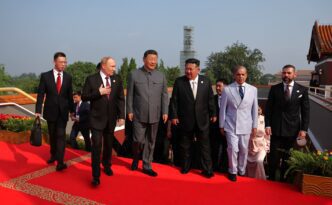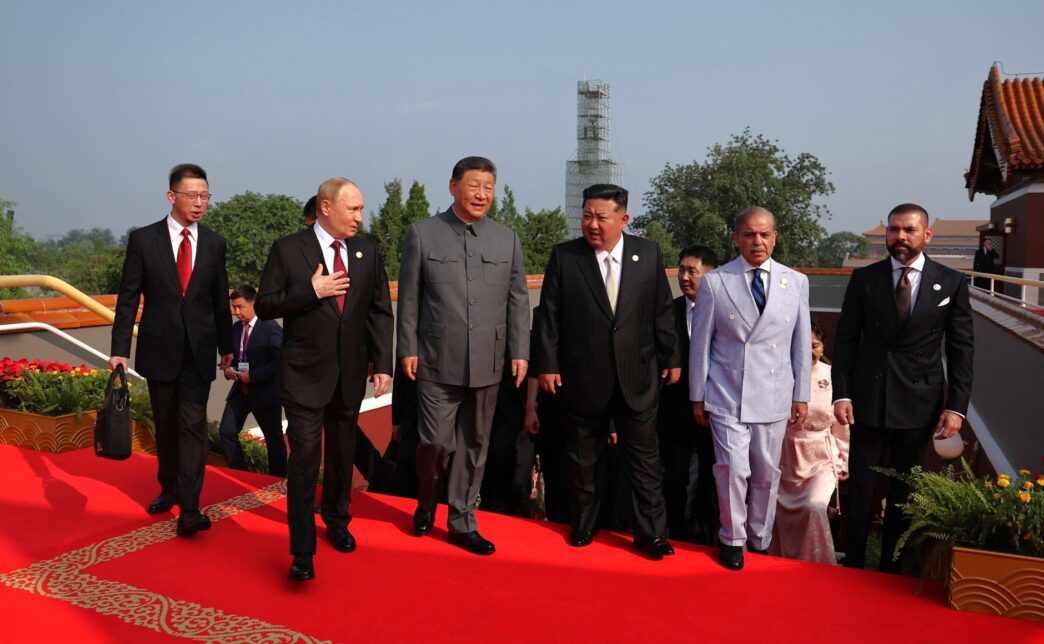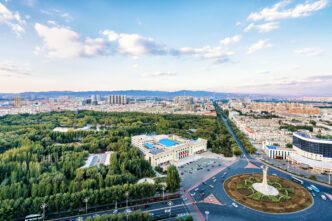Executive Summary
The Story So Far
Why This Matters
Who Thinks What?
A rare joint appearance by Chinese President Xi Jinping, Russian President Vladimir Putin, and North Korean leader Kim Jong Un in Beijing on September 3, 2025, during commemorations for the 80th anniversary of China’s victory over Japan in World War II, aimed to project unity among the three nations. While Beijing sought to signal solidarity and alignment against the West, this high-profile display has immediately prompted stronger security cooperation among Pacific nations and could significantly complicate China’s diplomatic standing and global relations.
The strategic placement of Putin and Kim alongside President Xi was a deliberate move by Beijing to communicate a unified front against Western influence. Western media outlets interpreted this as a clear signal of a potential new international order centered on China. However, an expert in Northeast Asian security and China’s grand strategy suggests that this approach may be creating new challenges for Beijing, potentially undermining its claims of neutrality and damaging relations with Europe and other Asian countries.
Immediate repercussions followed the Beijing event. Two days later, Japan and Australia agreed to enhance security cooperation in the Indo-Pacific region. On September 11, a new accord between Japan and the Philippines came into effect, allowing their armed forces to operate within each other’s territories, marking a collective show of unity against perceived Chinese assertiveness.
China’s Diplomatic Challenges
The deepening ties between China, Russia, and North Korea are not sudden, but rather a culmination of years of increasing tensions between China and Western nations. The ongoing conflict in Ukraine has been a primary factor in the deterioration of China-Europe relations, despite Beijing’s consistent claims of neutrality and calls for peace talks.
This visible alignment with Putin and Kim could undermine China’s diplomatic efforts, giving the impression that Beijing acquiesces to the Russia-North Korea partnership and their war efforts in Ukraine. Earlier in the year, China had reportedly signaled its dissatisfaction with Pyongyang for increasingly public military aid to Moscow, a position that now appears challenged by the joint appearance.
Impact on International Alliances
In Brussels, European Union foreign policy chief Kaja Kallas characterized the participation of the Chinese, Russian, Iranian, and North Korean leaders as an “authoritarian alliance” that challenges the existing rules-based international order. This development is likely to deepen Europe’s security concerns and further strain already fraught China-EU economic relations.
Such concerns could prompt the EU to expand anti-dumping measures against China or accelerate efforts to reduce economic dependence on Beijing. This would be a significant blow to China’s economy, as the EU was China’s largest source of imports in 2024, with trade reaching US$609 billion, and China’s second-largest export market.
Ironically, while President Donald Trump’s previous “America First” policies and outreach to Putin had strained transatlantic relations, the emerging China-Russia-North Korea alignment may have the opposite effect. It could drive Trump to strengthen cooperation with European allies to counter this new bloc.
On September 4, the day after the Beijing parade, Trump urged European leaders to increase economic pressure on China and accused Beijing of financing Russia’s war in Ukraine. The European Commission is reportedly already considering including several independent Chinese refineries in its latest round of sanctions against Russia, indicating a potential alignment of interests.
Hardening Regional Stances
The alliance of China, Russia, and North Korea also risks accelerating a “China containment strategy” that Beijing has previously sought to prevent. This strategy involves forging anti-Beijing alliances across the Pacific, evidenced by increased U.S.-Philippines naval exercises, U.S.-Indonesia-led multilateral exercises, and enhanced defense ties between Japan and the Philippines.
This emerging bloc is likely to push both Japan and South Korea, which currently maintain relatively moderate stances toward China, to distance themselves further from Beijing. Instead, they are expected to strengthen their alliances with the United States to counter the perceived threat.
Recent military activities underscore this shift. On September 11, the U.S. and Japan began two weeks of military exercises involving the Typhon intermediate-range missile system, capable of striking the Chinese mainland. Additionally, annual drills to bolster defenses against North Korea’s nuclear and missile threats are scheduled to begin on September 15, involving South Korea, Japan, and the U.S.
South Korea’s Policy Shift
Beijing’s embrace of North Korea could force South Korea’s ruling Democratic Party, which has typically favored a friendlier approach toward China and North Korea, to reconsider its policies. This could lead to a reversion to a more hostile stance, similar to that of the previous government under President Yoon Suk Yeol, who pursued a hard-line approach and actively sought trilateral cooperation with Washington and Tokyo.
China’s decision to invite Kim Jong Un, a leader long isolated and sanctioned by the international community, to a central role in Beijing has been widely interpreted as tacit recognition of North Korea’s nuclear capabilities. Notably, during the Xi-Kim summit on September 5, Beijing made no mention of the denuclearization of the Korean Peninsula, a significant omission that drew considerable attention from South Korean media and contrasted sharply with their four previous meetings.
Sino-Japanese Relations
Japan finds itself in a similar position to South Korea. Recently resigned Prime Minister Shigeru Ishiba, considered a pro-China moderate, had sought to build a more stable and constructive partnership with Beijing, marking a departure from his predecessor’s tough stance. However, the growing security concerns sparked by the China-Russia-North Korea alignment could compel Japan to adopt a tougher China policy in the future.
While Trump praised China’s parade as “beautiful” and “impressive,” he appeared displeased with the joint appearance of Xi, Putin, and Kim, stating on social media that their nations were “conspiring against” the United States.
Outlook
The September 3 parade undeniably signaled President Xi’s intent to build a new international order with China at its core. It projected a strong sense of deterrence toward the U.S. and the West, while also underscoring China’s dominant position within the trilateral relationship with Russia and North Korea. However, this high-profile alignment carries significant risks, potentially deepening Western and regional suspicions of an “axis of upheaval,” further straining China’s foreign relations, and accelerating balancing efforts against Beijing, most notably through closer transatlantic cooperation and a strengthening of the U.S.-Japan-South Korea alliance.








